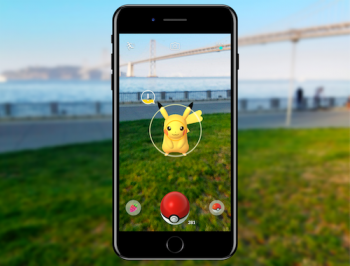Difference between revisions of "Augmented Reality"
(→Core AR features) |
|||
| Line 1: | Line 1: | ||
| + | [[file:pokemon go AR1.png|350px|right]] | ||
'''[https://vrarwiki.com/wiki/Augmented_reality Augmented Reality] [https://vrarwiki.com/wiki/AR (AR)]''' is a technology that overlays computer-generated images, sounds, and contextual data onto the real world, creating an interactive composite view. Unlike [https://vrarwiki.com/wiki/Virtual_reality Virtual Reality], which replaces the user’s surroundings entirely, AR supplements reality, letting digital [[Pokémon]] appear on streets, in parks, or even on a player’s desk. Since its launch in July 2016, Pokémon GO has continuously expanded its AR tool-set, evolving from a simple camera overlay into sophisticated, persistent, and shared experiences that leverage surface detection, spatial mapping, and cloud anchoring. | '''[https://vrarwiki.com/wiki/Augmented_reality Augmented Reality] [https://vrarwiki.com/wiki/AR (AR)]''' is a technology that overlays computer-generated images, sounds, and contextual data onto the real world, creating an interactive composite view. Unlike [https://vrarwiki.com/wiki/Virtual_reality Virtual Reality], which replaces the user’s surroundings entirely, AR supplements reality, letting digital [[Pokémon]] appear on streets, in parks, or even on a player’s desk. Since its launch in July 2016, Pokémon GO has continuously expanded its AR tool-set, evolving from a simple camera overlay into sophisticated, persistent, and shared experiences that leverage surface detection, spatial mapping, and cloud anchoring. | ||
Latest revision as of 06:23, 27 April 2025
Augmented Reality (AR) is a technology that overlays computer-generated images, sounds, and contextual data onto the real world, creating an interactive composite view. Unlike Virtual Reality, which replaces the user’s surroundings entirely, AR supplements reality, letting digital Pokémon appear on streets, in parks, or even on a player’s desk. Since its launch in July 2016, Pokémon GO has continuously expanded its AR tool-set, evolving from a simple camera overlay into sophisticated, persistent, and shared experiences that leverage surface detection, spatial mapping, and cloud anchoring.
For a broader introduction to AR concepts, see the AR Wiki.
Historical development
| Year | Milestone | Key details |
|---|---|---|
| 2016 | Launch overlay | Basic camera passthrough. optional toggle for battery savings. |
| 2017 | AR+ (iOS) | Surface detection, proximity ‘‘stealth’’ meter, and Expert Handler bonus on ARKit devices. |
| 2018 | AR+ on Android | Requires ARCore-compatible phones running Android 7.0+. |
| 2019 | GO Snapshot | Stand-alone photo mode for any stored Pokémon. supports social sharing and Smeargle photobombs. |
| 2019 | Buddy Adventure | Let Trainers interact with and photograph buddies together in Shared AR. |
| 2020 | Reality Blending & AR Mapping | Depth-based occlusion and crowd-sourced PokéStop Scan tasks. |
| 2024 | Pokémon Playgrounds | VPS-anchored, persistent AR that other players can see. |
Core AR features
AR Catching & AR+
- Standard AR mode places the wild Pokémon in the centre of the camera feed and tracks the device’s gyroscope and accelerometer for orientation.
- AR+ mode (2017 iOS / 2018 Android) anchors Pokémon to detected planes, renders them at canonical scale, and introduces an awareness meter, an approach too quickly and the target may flee.
GO Snapshot
Players can choose any caught Pokémon, place it on a detected surface, reposition it, and capture photos. Smeargle and special-event photobombs may appear after a snapshot session.
In Play Together, Trainers feed, pet, and walk with their Buddy Pokémon rendered in real space. Shared AR syncs up to three buddies for group photos.
Reality Blending
Supported devices use depth APIs to let Pokémon move behind furniture or trees, improving realism through occlusion.
AR Mapping tasks
Field Research labelled AR Mapping asks Trainers to record short, anonymised videos of PokéStops. these scans refine Niantic’s 3-D maps and unlock in-game bonuses such as powered-up PokéStops.
Pokémon Playgrounds
An experimental feature that lets Trainers anchor Pokémon persistently at real-world landmarks for others to discover and photograph, enabled by Niantic’s Visual Positioning System.
Technology stack
| Layer | Implementation |
|---|---|
| Device frameworks | ARKit plane-finding on iOS 11+ devices and ARCore Plane APIs on Android 7+ phones |
| Niantic Lightship ARDK | Cross-platform SDK adding meshing, depth, semantic segmentation, and multiplayer. |
| Visual Positioning System | Cloud-hosted anchors power Playgrounds and future persistent content. |
| Networking | Peer-to-peer sessions synchronise transforms for Shared AR. |
Gameplay impact
- Immersion and creativity – AR photography (#GOsnapshot), Reality Blending, and Playgrounds deepen the illusion that Pokémon coexist with the physical world.
- Physical activity – AR incentives encourage exploration. studies report increased daily step counts among active players.
- Social connection – Shared AR sessions and Playgrounds create collaborative in-person moments.
Challenges and limitations
- Battery and processing load – Continuous camera, sensor fusion, and real-time rendering drain power, especially on older devices.
- Environmental constraints – Very dim or over-bright settings reduce surface-tracking accuracy. textured, well-lit areas work best.
- Accessibility – Advanced features require ARKit-/ARCore-certified phones. players on legacy hardware can disable AR to maintain performance.
Influence on AR industry
Pokémon GO’s mainstream success validated mobile AR design, inspiring titles such as Harry Potter: Wizards Unite and Jurassic World Alive and driving developer interest in Unity’s AR Foundation. The game has been credited with popularising inside-out, marker-less tracking for consumer devices.
Future outlook
Niantic has signalled plans for richer occlusion, weather-aware behaviours, and eventual headset support, leveraging its Large Geospatial Model and continued Lightship ARDK updates.
